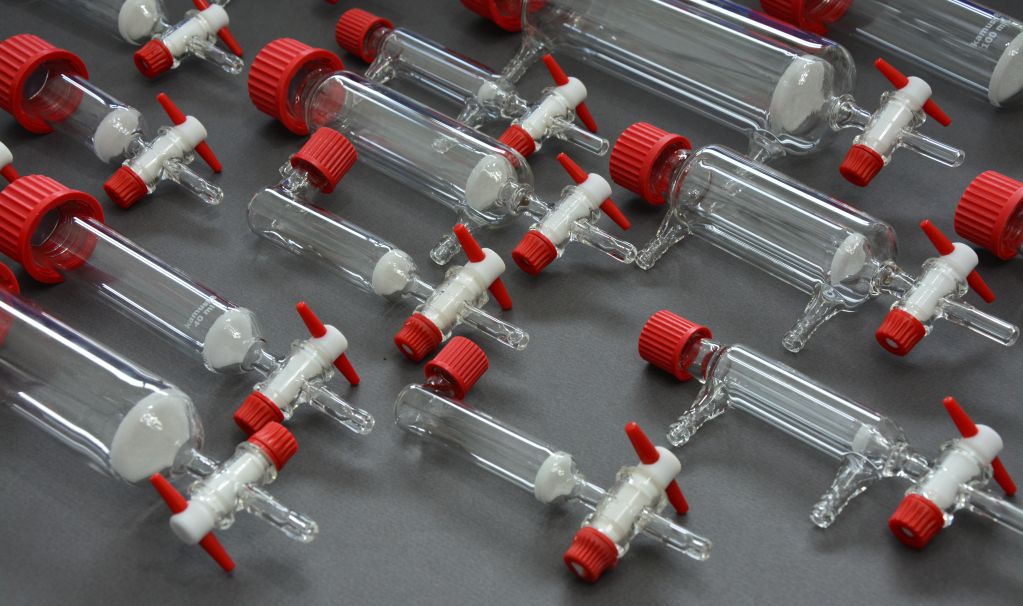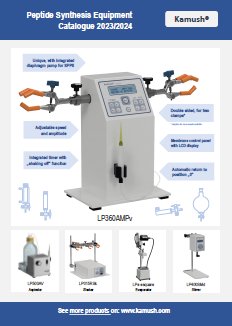(Peptideweb protocol, www.peptideweb.com)
Reagents: Wang resin, dichloromethane (DCM), N,N-dimethylformamide (DMF), Nα-(9-Fluorenylmethoxycarbonyl) - amino acid (Fmoc-AA), 1-hydroxybenzotriazole (HOBt), 4-(N,N-dimethylamino)-pyridine (DMAP), N,N′-diisopropylcarbodiimide (DIC), N,N-diisopropylethylamine (DIPEA).
- Swell the resin in the mixture of DCM and DMF (9:1, v/v; 10 mL/g). Transfer resin to the vessel.
- Dissolve completely 4 eq (relative to the resin) of the Fmoc-AA and 4 eq of HOBt in a minimum amount of DMF. Subsequently, add reagents to the resin.
- Dissolve 0.1 eq of DMAP in minimum volume of DMF.
- Add 4 eq of DIC to the resin and agitate. Next add the DMAP/DMF.
- Agitate the mixture with a mechanical shaker for 12 hours at room temperature. To end-cap unreacted hydroxyl groups discard the mixture and add 2 eq of acetic anhydride and 2 eq of DIPEA in DCM. Agitate for an additional 30 minutes at room temperature.
- Subsequently, filter the resin and wash it three times with DMF, then three times with DMF/DCM (1:1, v/v) and three times with DCM. Dry the resin in vacuo. Estimate the substitution level of the resin spectrophotometrically and/or from the weight gain.
Attachment of the first amino acid on 2-chlorotrityl chloride resin
(Peptideweb protocol, www.peptideweb.com)
Reagents: 2-chlorotrityl chloride resin, dichloromethane (DCM), N,N-dimethylformamide (DMF), Nα-(9-Fluorenylmethoxycarbonyl) - amino acid (Fmoc-AA), N,N′-diisopropylcarbodiimide (DIC), N,N-diisopropylethylamine (DIPEA), methanol (MeOH).
- Swell the resin in dichloromethane (DCM; 10 ml/g). Transfer resin to the vessel.
- Use 2 eq of Fmoc-AA and 4 eq of DIPEA. Dissolve reagents in DCM. If it is not effective use ultrasonic and/or add minimum volume of DMF. After resin swelling, aspirate DCM from a vessel and subsequently add reagents to your resin. Reaction should be carried out at room temperature with agitation for 30 minutes to 2 hours.
- Discard the solution and prepare capping mixture - DCM:MeOH:DIPEA (17:2:1, v/v). Add capping mixture to your resin and agitate at least 30 minutes.
- Subsequently, filter the resin and wash it with two volumes of DMF and DCM. Estimate the substitution level of the resin spectrophotometrically and/or from the weight gain.
A spectrophotometric determination of resin loading
(Peptideweb protocol, www.peptideweb.com)
Reagents and materials: spectrophotometer, quartz cuvette (path length 10 mm), Fmoc-AA loaded resin, 20 % piperidine in DMF.
- Weight dry resin into the glass bottle (a few milligrams). To obtain more accurate result prepare two or more samples.
- Add 20% piperidine in DMF (1.5 mL/mg) and provide agitation (magnetic stirrer) for 10 minutes at room temperature.
- Use 20% piperidine in DMF as a blank sample (λ=290nm). Next, measure absorbance of rest of the sample(s).
- To estimate loading use equation below.

Peptide reactors
For more information click
Other protocols attachment methods
1. AAPPTEC
(www.aapptec.com)
Attachment of Amino Acids to Wang Resins
- In a round bottom flask suspend the resin in 9:1 v/v CH2Cl2/DMF (approximately 15 mL per gram of resin).
- In a separate flask dissolve 1.5 to 2.5 equivalents (relative to the resin) of the carboxylic acid in a minimum amount of DMF. Add the same equivalency of HOBt. Stir the mixture until the HOBt dissolves. If the HOBt doesn’t dissolve completely, add DMF to bring it into solution. Add this solution to the resin.
- In a separate flask dissolve 0.1 equivalent (relative to the resin) of DMAP in a minimum amount of DMF.
- Add 1.0 equivalent (relative to the carboxylic acid) of DIC to the resin mixture then add the DMAP solution. Equip the flask with a drying tube.
- Agitate the mixture with a mechanical shaker for 2 to 3 hours at room temperature. Add 2 equivalents (relative to the resin) of acetic anhydride and pyridine to the reaction flask and mix an additional 30 minutes at room temperature to end cap any unreacted hydroxyl groups on the resin.
- Filter the resin in a fine porosity sintered glass funnel and wash it 3 times with DMF, then 3 times with DCM, and finally 3 times with methanol. In each wash use enough solvent to slurry the resin. After the final methanol wash, dry the resin in vacuo to a constant weight.
Attachment of Amino Acids to Trityl Chloride Resins
- Use 1.0 equivalent of the protected amino acid. If a lower substitution resin is required, reduce the amount of acid. Dissolve the amino acid in DCM (approximately 10 mL per gram of resin). If the acid does not dissolve in completely, add a small amount of DMF.
- Add the amino acid solution to the resin. Add 1.0 equivalent (respective to the acid) of DIPEA. Agitate the mixture with a shaker for 5 minutes, then add 1.5 equivalents (respective to the acid) of DIPEA. Agitate the mixture vigorously for 30 to 60 minutes.
- To endcap any remaining reactive trityl groups, add HPLC grade methanol, 0.8 mL per gram of resin, and mix for 15 minutes. Filter the resin and wash it three times with DCM, using approximately 10 mL per gram of resin. Wash the resin twice with DMF, twice with DCM, and three times with methanol. Dry the resin in vacuo. The substitution of the resin can be estimated from the weight gain.
2. AnaSpec
(www.anaspec.com)
Procedure for Loading Fmoc-Amino Acid to 2-Chlorotrityl Chloride Resin
- Weigh 10 g 2-chlorotrityl chloride resin (15 mmol) [1 g, AnaSpec Catalog # 22229; 5 g, AnaSpec Catalog # 22230] in a reaction vessel, wash with DMF (2x), swell the resin in 50 mL DMF for 10 min, drain vessel.
- Weigh 10 mmol Fmoc-amino acid in a test tube, dissolve Fmoc-amino acid in 40 mL DMF, transfer the solution into the reaction vessel above, add 8.7 mL DIEA (50 mmol), swirl mixture for 30 min at room temperature.
- Add 5 mL methanol into the reaction vessel and swirl for 5 min.
- Drain and wash with DMF (5x).
- Check substitution.
- Add 50 mL 20% piperidine to remove the Fmoc group. Swirl mixture for 30 min.
- Wash with DMF (5x), DCM (2x), put resin on tissue paper over a foam pad and let dry at room temperature overnight under the hood. Cover the resin with another piece of tissue paper, press lightly to break aggregates.
- Weigh loaded resin.
- Pack in appropriate container.
Other measuring protocols:
1. AAPPTEC
Measuring Substitution of Fmoc–Amino Acid Resin
(www.aapptec.com)
- Accurately weigh approximately 10 mg of resin into a 2 mL microcentrifuge tube.
- Add 1 mL of 20% (v/v) piperidine in DMF.
- Vortex briefly and agitate 1 hour at room temperature on a rotary shaker.
- Vortex the tube and allow the resin to settle for 2 minutes.
- Dilute 50 microliters of the supernate to 5 mL with DMF (dilution factor = 0.01).
- Prepare a blank by diluting 50 microliters of 20% (v/v) piperidine to 5 mL with DMF.
- Measure the absorbance of the sample versus the blank at 278 nm.
- Calculate the absorbance using the following formula:
S(mmol/g)=(1000·A)/(M·7800·D)
S=substitution of the resin in mmol/g
A=absorbance of the sample-absorbance of the blank
M=mass of the resin used (in milligrams)
D=dilution factor
Peptide calculator
Count substitution of the resin (mmol/g)
Substitution:
2. AnaSpec
(www.anaspec.com)
- Procedure for Checking Substitution of Fmoc-Amino Acid Loaded Resins
- Weigh duplicate samples of 5 to 10 mg loaded resin in an eppendorf tube, add 1.00 mL 20% piperidine/DMF, shake for 20 min, centrifuge down the resin.
- Transfer 100 µL of the above solution into a tube containing 10 mL DMF, mix well.
- Pipette 2 mL DMF into each of the two cells (reference cell and sample cell), set spectrophotometer to zero. Empty the sample cell, transfer 2 mL of the solution from step 2 into the sample cell, check absorbance.
- Subs = 101(A)/7.8(w)
A = absorbance
w = mg of resin
5. Check absorbance three times at 301 nm, calculate average substitution.


